GoPro Hero 11 Black vs DJI Osmo Action 3: which action cam should you buy?
DJI’s deep sea diver takes on GoPro’s social media superstar
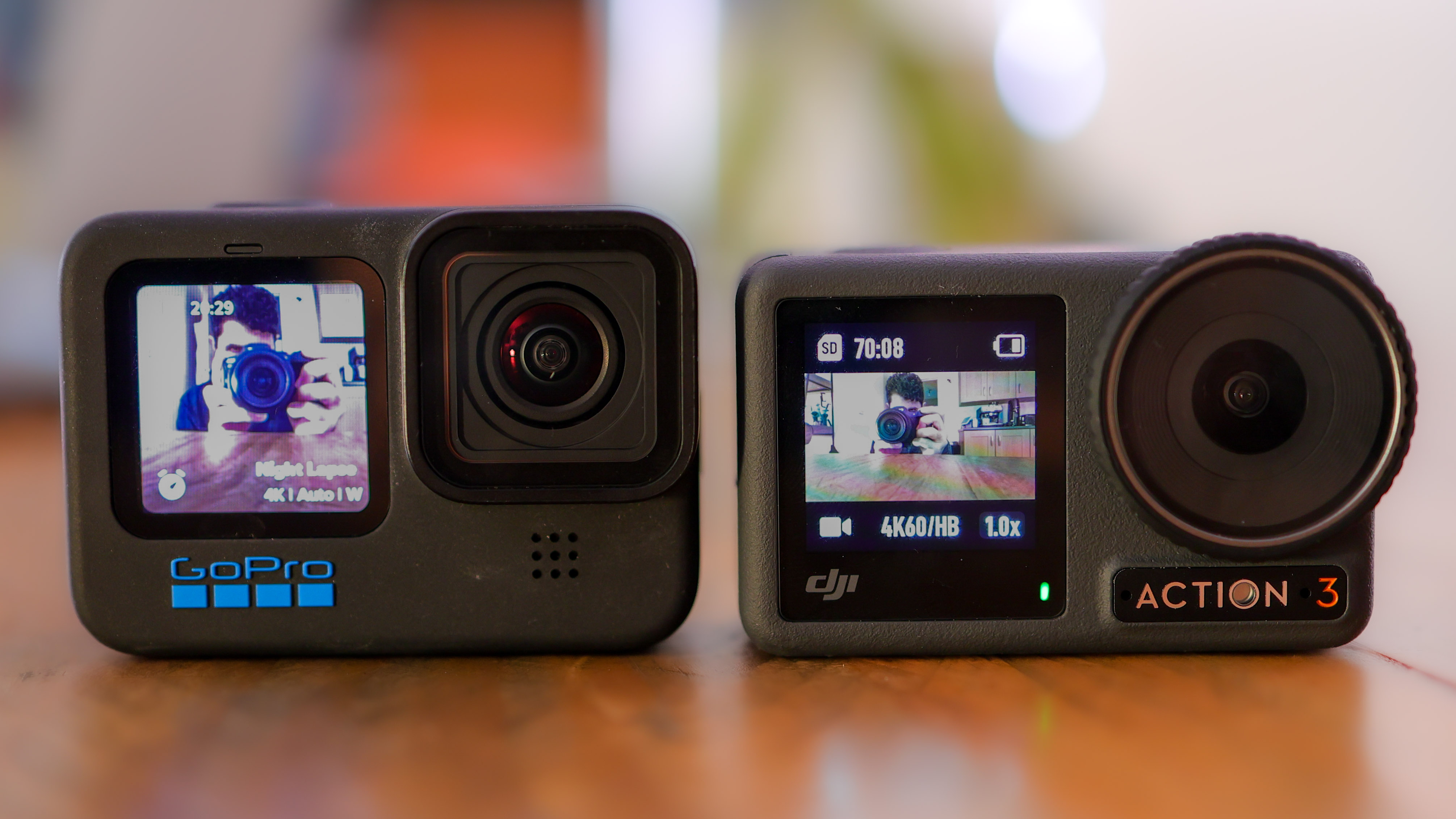
GoPro is still the byword for action cams, but DJI is an increasingly strong rival. The drone maker has been making its own tough cams for years – so how does its latest, the DJI Osmo Action 3, compare with the new GoPro Hero 11 Black? And which should you aim to buy in this year's Black Friday deals?
GoPro’s Hero 11 Black is exciting. It shakes things up with its larger sensor that has a nearly square 8:7 aspect ratio. It also introduces an upgrade to GoPro’s camera software that makes it better for novices, and it still supports a wealth of mods and accessories owners of older GoPros can repurpose if they pick up the latest, greatest Hero.

How does DJI hope to take on the leader of the action camera pack? It starts its assault with price, undercutting both last year’s GoPro Hero 10 Black as well as the new 11 Black. A lower price doesn’t mean inferior features across the board, though, with the DJI Osmo Action 3 introducing a more durable body that can withstand depths of up to 16m.
But is the Hero 11 Black still the one to target in this year's Black Friday GoPro deals? Or does DJI take on the established action camera champion and win? Here are eight main differences between the two action cameras to help you decide, followed by our final verdict.
GoPro Hero 11 Black vs DJI Osmo Action 3: price and packages
It's no simple task comparing the prices of a GoPro Hero 11 Black and a DJI Osmo Action 3, as what you pay will depend on a number of factors: which package you opt for, what subscription you have, and where you are in the world.
The GoPro Hero 11 Black costs $399.98 / £399.98 / AU$649.95 if bundled with a GoPro Subscription, or for $499.99 / £499.99 / AU$799.95 with no GoPro Subscription.
The DJI Osmo Action 3, by contrast, costs a fair bit less: $329 / £309 / AU$519 in its lowest-cost package, and DJI has also launched the Adventure Combo for $439 / £399 / AU$719.
Sign up for breaking news, reviews, opinion, top tech deals, and more.
You can see the range of packages and prices outlined below:
| Model | Price (with GoPro Subscription) | Price (without GoPro Subscription) |
| GoPro Hero 11 Black | $399.98 / £399.98 / AU$649.95 | $499.99 / £499.99 / AU$799.95 |
| GoPro Hero 11 Black Creator Edition | $579.98 / £579.98 / AU$929.95 | $699.99 / £699.99 / AU$1,099.95 |
| DJI Osmo Action 3 | / | $329 / £309 / AU$519 |
| DJI Osmo Action 3 Adventure Combo | / | $439 / £399 / AU$719 |
Going into a bit more detail on what each package consists of, the Creator Edition GoPro Hero 11 Black includes the Volta battery grip, Media Mod, Light Mod, as well as the core camera pack – the camera and an Enduro battery.
The DJI Osmo Action 3 Adventure Combo combines the camera with a host of mounts, a total of three batteries, and a charging cradle for them, in addition to a grip and portrait-orientation mountable housing.
It's possible that both of these cameras could see discounts or offers in the Black Friday GoPro deals or Black Friday DJI deals, so check out our respective guides on those for the latest news from deals town.
GoPro Hero 11 Black vs DJI Osmo Action 3: Sensors
The biggest practical difference between the GoPro Hero 11 Black and other action cameras is the sensor – specifically, its shape.
The Hero 11 Black's new 8:9 sensor features a more square aspect ratio that makes it better suited to portrait and landscape orientation crops than the traditional 4:3 sensor of the DJI Osmo Action 3.
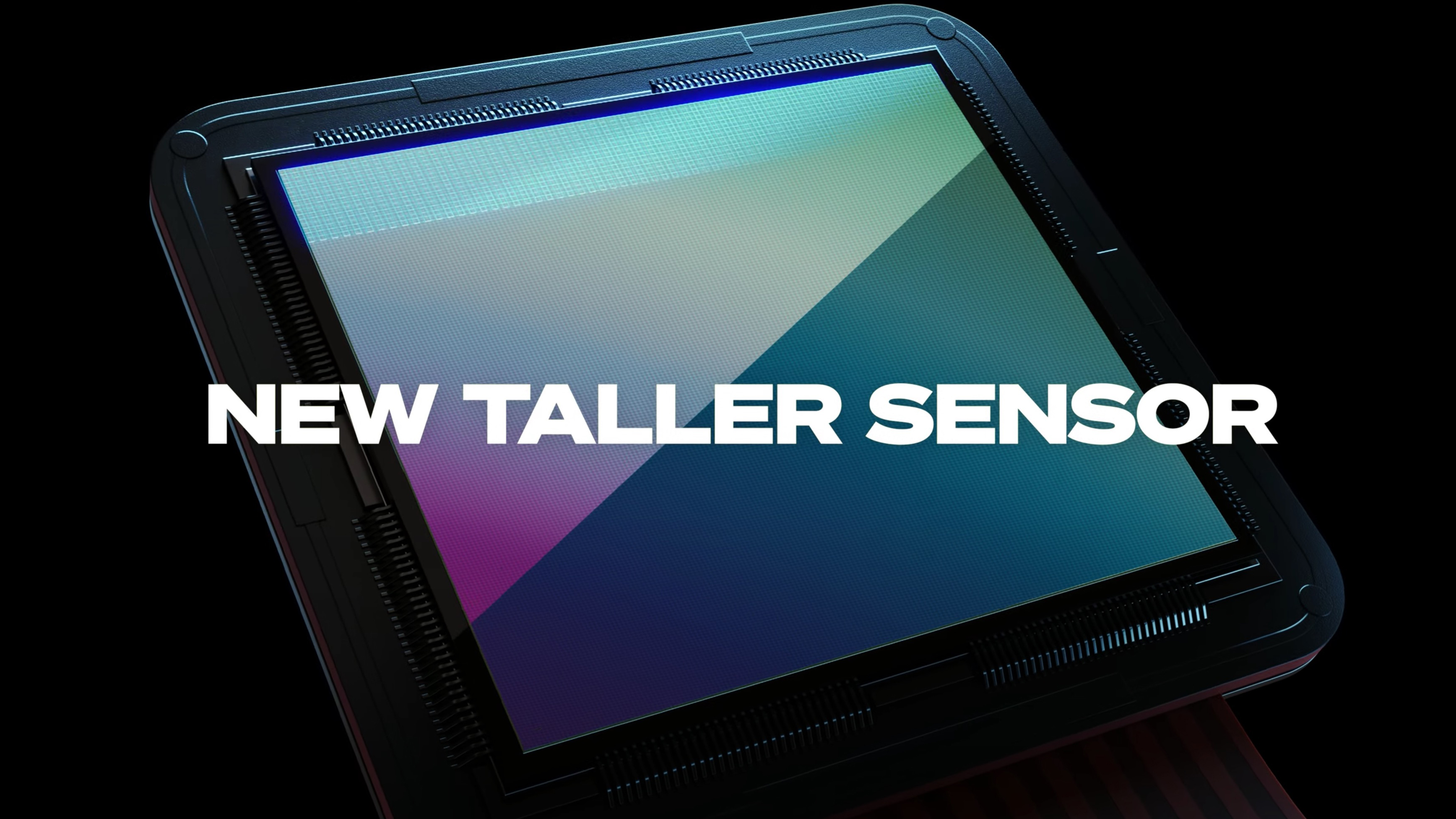
Why would you want to export a single clip in either portrait or landscape orientation? To feed your hungry social media channels – portrait for Instagram Reels and TikTok, landscape for YouTube.
The Hero 11 Black also enjoys a higher resolution than the DJI Osmo Action 3, clocking in at 27MP versus 12MP. That benefit obviously means that the photo resolution of GoPro's flagship camera will be significantly higher – over double that of DJI's. And it also means the Hero 11 Black can capture 5.3K video too, both in 16:9 and 8:7 aspect ratios.
Despite its big pixel count, the Hero 11 Black sensor isn't exactly huge at 1/1.9-inch. In fact, the DJI Osmo Action 3's sensor is larger at 1/1.7-inch – suggesting it should be better able to handle lowlight environments. As we'll come onto, that isn't the case – GoPro's software does wonders with the tiny hardware at hand and edges ahead in dimly-lit environments.
GoPro Hero 11 Black vs DJI Osmo Action 3: Image and video quality
The GoPro Hero11 Black bests the DJI Osmo Action 3 in a number of ways when it comes to image quality. For starters, it captures a fuller dynamic range than DJI's camera, better able to balance highlights in the sky and shadows in one frame. It's also a 10-bit camera, just like an iPhone 14 Pro, so handles gradients with less banding than the 8-bit DJI Osmo Action 3.
GoPro's camera processing also helps the Hero 11 Black's lowlight footage look less noisy and more usable – though neither camera does a good job when the lights drop. Nevertheless, with the inclusion of some night modes, specifically, Light Painting, GoPro finds some fun workarounds to help edge the 11 Black even further ahead in challenging scenes.
Video enthusiasts who want maximum resolution and frame rates can expect similar results across both cameras in standard video mode, thanks to the cameras' 16:9 4K video captured at up to 120fps, and 2.7K footage at up to 240fps.
For anyone who wants a more squat aspect ratio, the GoPro Hero 11 Black shoots 8:7, 5:3K footage at up to 30fps, and 16:9 5.3K footage at up to 60fps. That's versus a maximum resolution of 4K (4:3) at 60fps on the DJI Osmo Action 3.
While the GoPro Hero 11 Black edges ahead when it comes to frame rates and resolutions, though, the DJI Action 3 can shoot with a wider horizontal field of view, thereby getting even more in frame in a 16:9 video.
GoPro Hero 11 Black vs DJI Osmo Action 3: Diving Depths
When you think of underwater action cameras, shark cage capture and deep(ish) sea diving footage, you might think GoPro’s the way to go, complete with underwater housing if you’re really pushing the limits. But DJI goes deeper than the Hero 11 Black with its new Osmo Action 3.
For over a decade, 10 meters, which works out to around 32 feet, has been the standard maximum depth that action cameras like the Hero 10 Black, could handle. Now, DJI pushes things all the way to 16m – over 53 feet.
So while your GoPro Hero 11 Black might need underwater housing if you want to use it in a shark cage, for example, which is generally submerged between 10 and 15m, the Osmo Action 3 won’t.
You might not need underwater housing for deep swims, but you will need to activate a special mode that disables the touchscreen. This means you’ll be reliant upon the buttons for capture, and you won’t be able to change the settings underwater, but provided the camera’s doors are well sealed, it shouldn’t drown under pressure.
GoPro Hero 11 Black vs DJI Osmo Action 3: Horizon locking
GoPro's HyperSmooth 5.0 adds a new horizon lock option for the Hero 11 Black, and one-ups DJI at its own game.
Before we go into the details of the two camera's leveling abilities, let's talk about exactly what horizon leveling and locking are. Horizon leveling refers to a feature that keeps your footage looking level with the horizon even if you tilt it left and right – usually up to around 45 degrees. Meanwhile, horizon locking takes you from 45 degrees all the way to 360 degrees so that you can loop-de-loop with your camera, and your footage will look like it was held perfectly level with the horizon line.
While DJI introduced a locked horizon in its DJI Action 2, capping at 2.7K resolution, it hasn't upped the stakes with the Osmo Action 3. Meanwhile, GoPro has bumped up horizon locking on the Hero 11 Black to work at maximum resolution – 5.3K, at 16:9 aspect ratio.
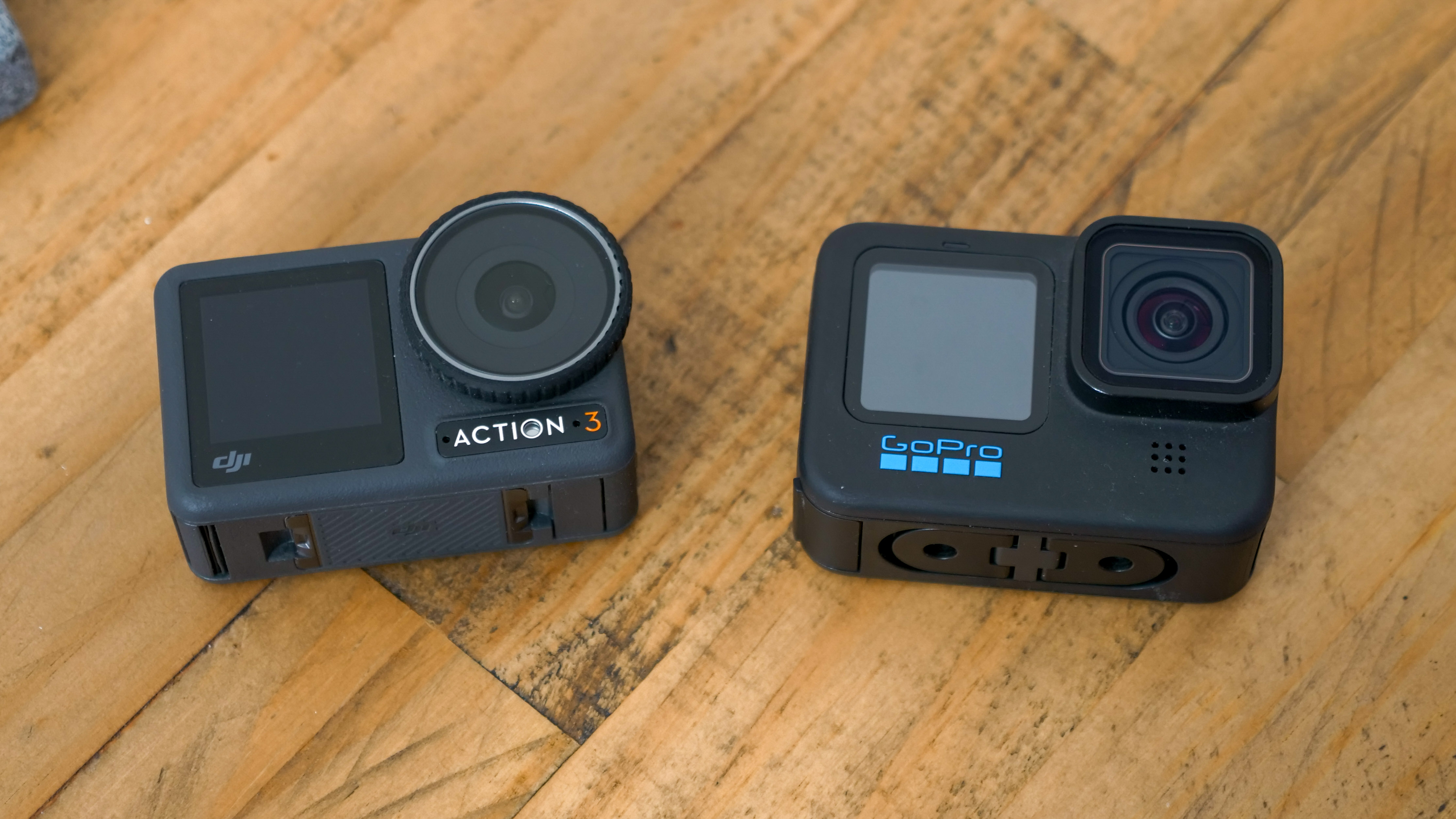
This is a huge win for GoPro, and its horizon-locked footage looks superior to that of the Osmo Action 3, capturing with a wider field of view – better for vloggers.
It isn't just vloggers who can benefit from superior horizon leveling and locking – the tech makes shooting swaying footage – on water, for example, or motorbike footage, look incredibly cinematic.
GoPro Hero 11 Black vs DJI Osmo Action 3: Battery life
Comparing battery life across action cameras is tricky. Of course, the obvious place to start is battery capacity – the number of milliamp-hours in a single battery from each challenger. This approach would give the win to DJI, with its 1770mAh battery edging ever so slightly ahead of the 1720mAh battery inside the GoPro Hero 11 Black.
It's also worth noting that if you pick up the DJI Osmo Action 3 in the Adventurer Combo, it ships with three batteries as well as a portable USB-C charger so you can easily hot-swap when one's empty. This is all pointing to a win for DJI.
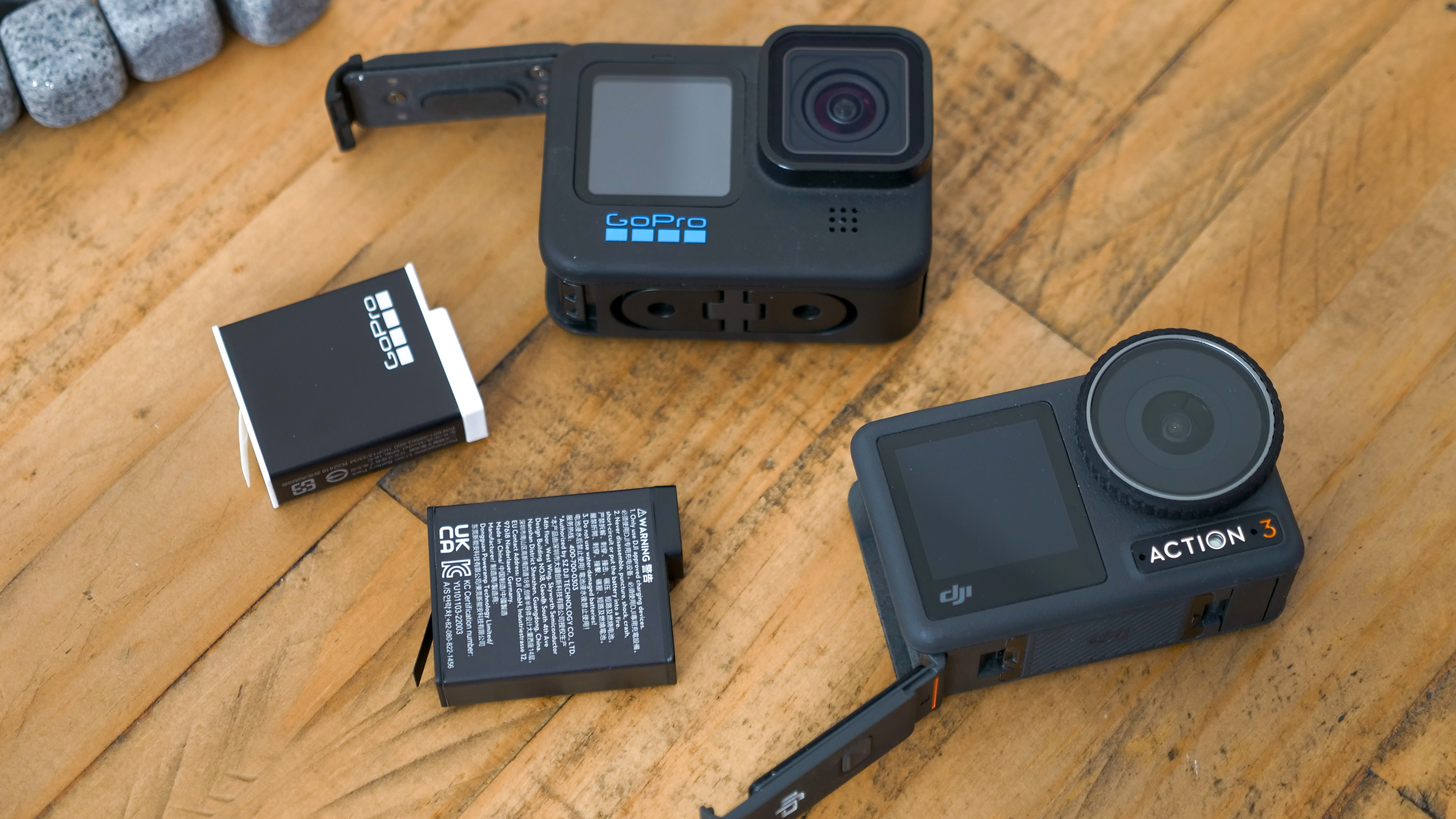
Battery performance isn't quite so cut and dry when it comes to action cameras, though. The GoPro Hero 11 Black ships with an Enduro battery out of the box, and it can get as cold as -10ºC before it stops charging. Given it generates heat when recording, the ambient temperature can, in turn, be significantly lower before the battery itself hits conks out. Sounds impressive, right?
The Enduro battery is mighty, but DJI's edged ahead with its battery by breaking down the battery performance into charging and recording temperatures. The Osmo Action 3 battery can operate the camera at temperatures as low as -20º, and charge at temperatures as low as 5ºC.
With the Action 3's battery also lasting slightly longer than that of the Hero 11 Black when recording 4K footage, it's a battery win for DJI. If you're thinking about picking up a GoPro, though, and want to make sure your camera goes the distance, you'll probably want to get some spare batteries or a Volta battery grip.
GoPro Hero 11 Black vs DJI Osmo Action 3: Mounting
The GoPro Hero 11 Black brings back the flip-out feet introduced on the Hero 8 Black. This means that without any housing, the 11 Black can be securely fixed onto any traditional action camera mount accessory. When it was introduced, these little flip-out feet were revolutionary, saving on bulk and the need for extra accessories.
In a turn for the books, DJI has one-upped GoPro for 2022, bringing back its magnetic mounting system, which was introduced on the DJI Action 2, and adding it to the Osmo Action 3.
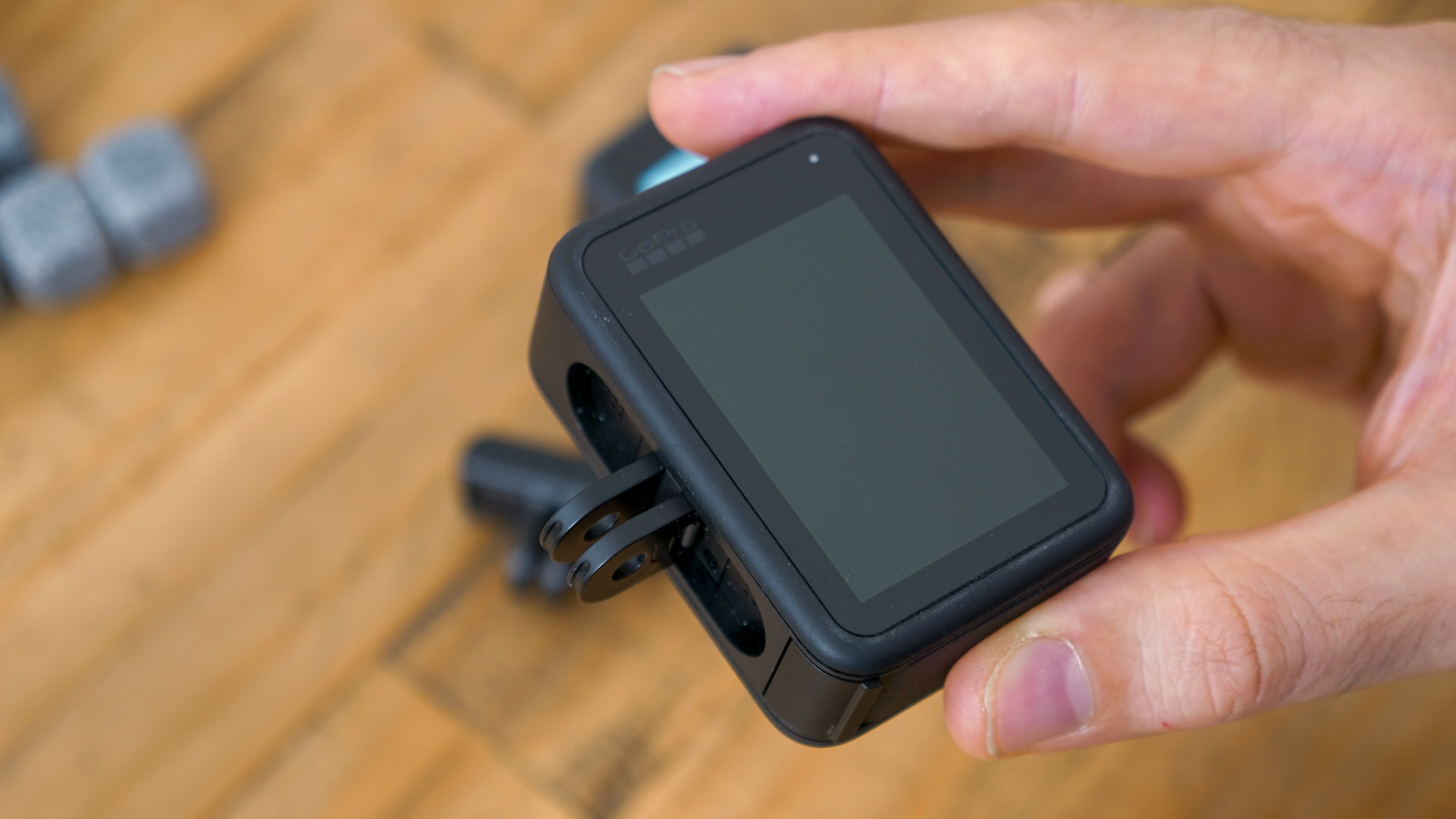
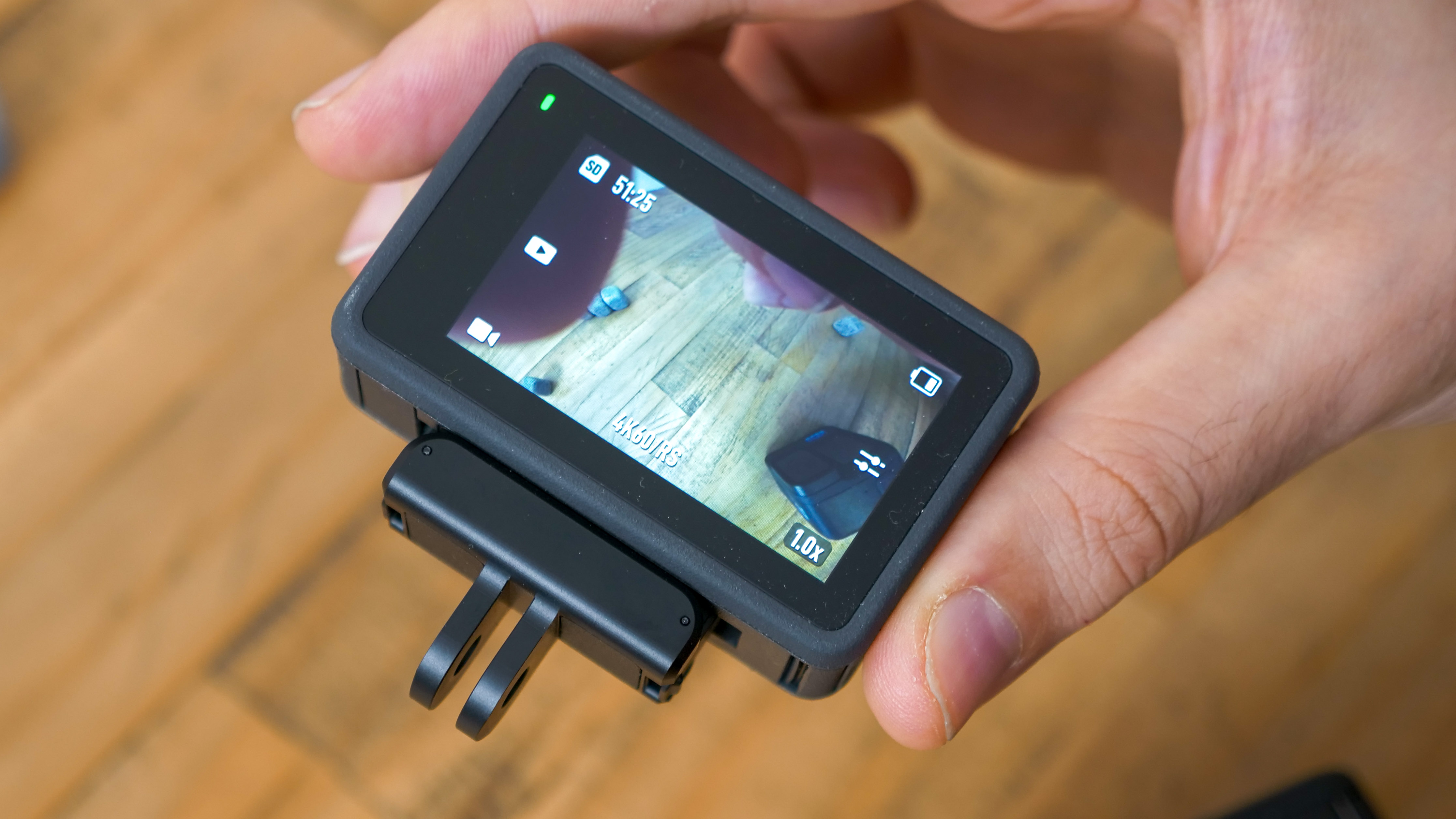
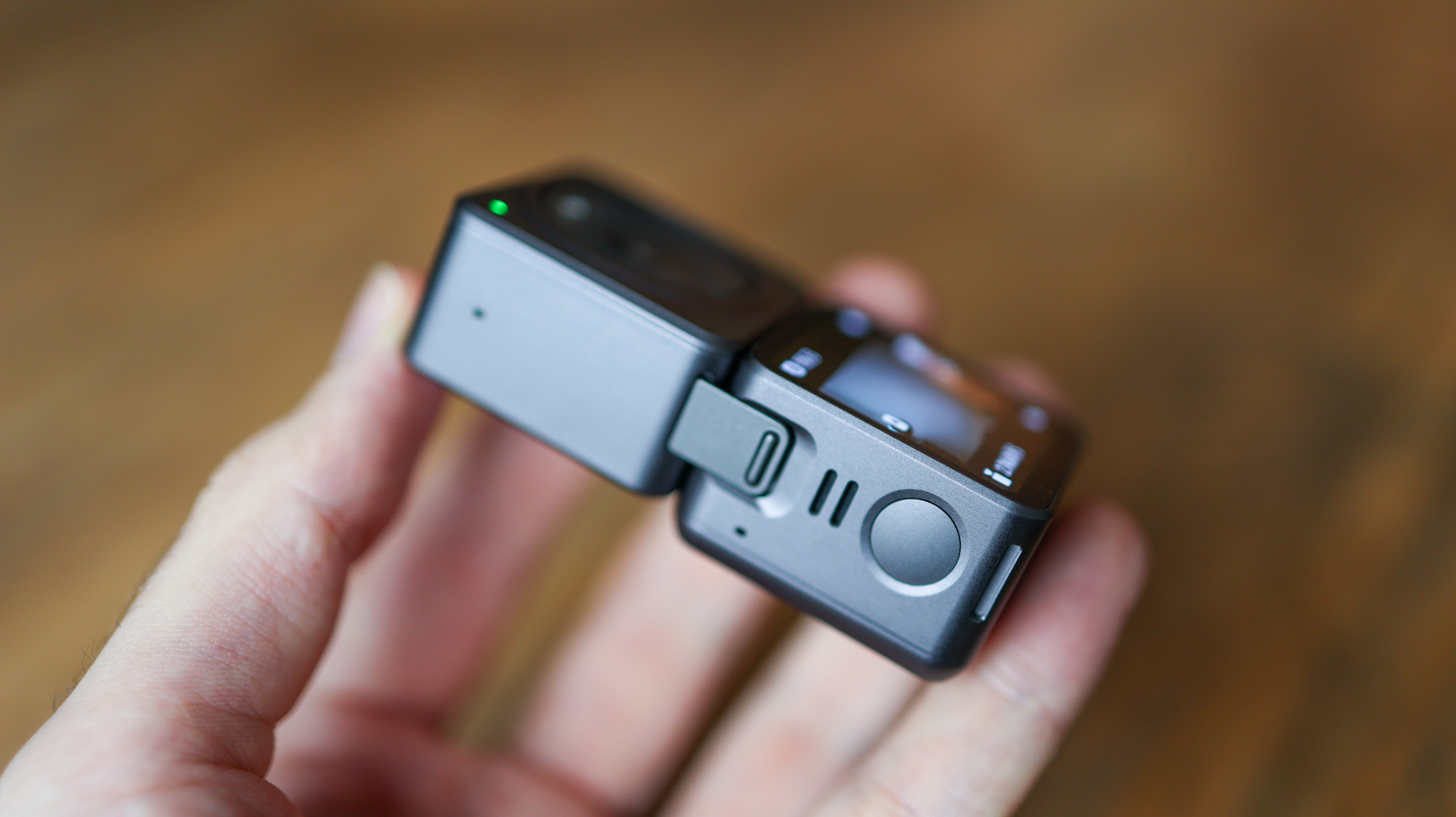
DJI's magnetic mounting isn't perfect – it requires a magnetic plate to live on your mount, and these cost around $25 / £19 / AU$29, adding some height to the system. That said, once your plate is affixed to your mount, you can quickly and easily clip and unclip your Action 3 on and off your mount in seconds – much quicker than screwing and unscrewing the whole camera on and off, as required by the Hero 11 Black.
GoPro Hero 11 Black vs DJI Osmo Action 3: Low light performance
For those of you who don't want to completely ditch your action camera when the lights drop, the Hero 11 Black adds three timelapse presets that capture lowlight video with a twist, and it includes a Night Photo mode too. None of these camera modes are available on the DJI Osmo Action 3.
The first of these new GoPro Hero 11 modes is Light Painting, which employs a long exposure in a dark environment to create brush stroke effects with moving light. We played around with this feature during testing, and although it can be tricky to master, the results were so unique that even botched attempts could be passed off as deliberately artistic. The same goes for Vehicle Light trails, which uses the same technique to capture trailing light from (you guessed it!) moving vehicles.
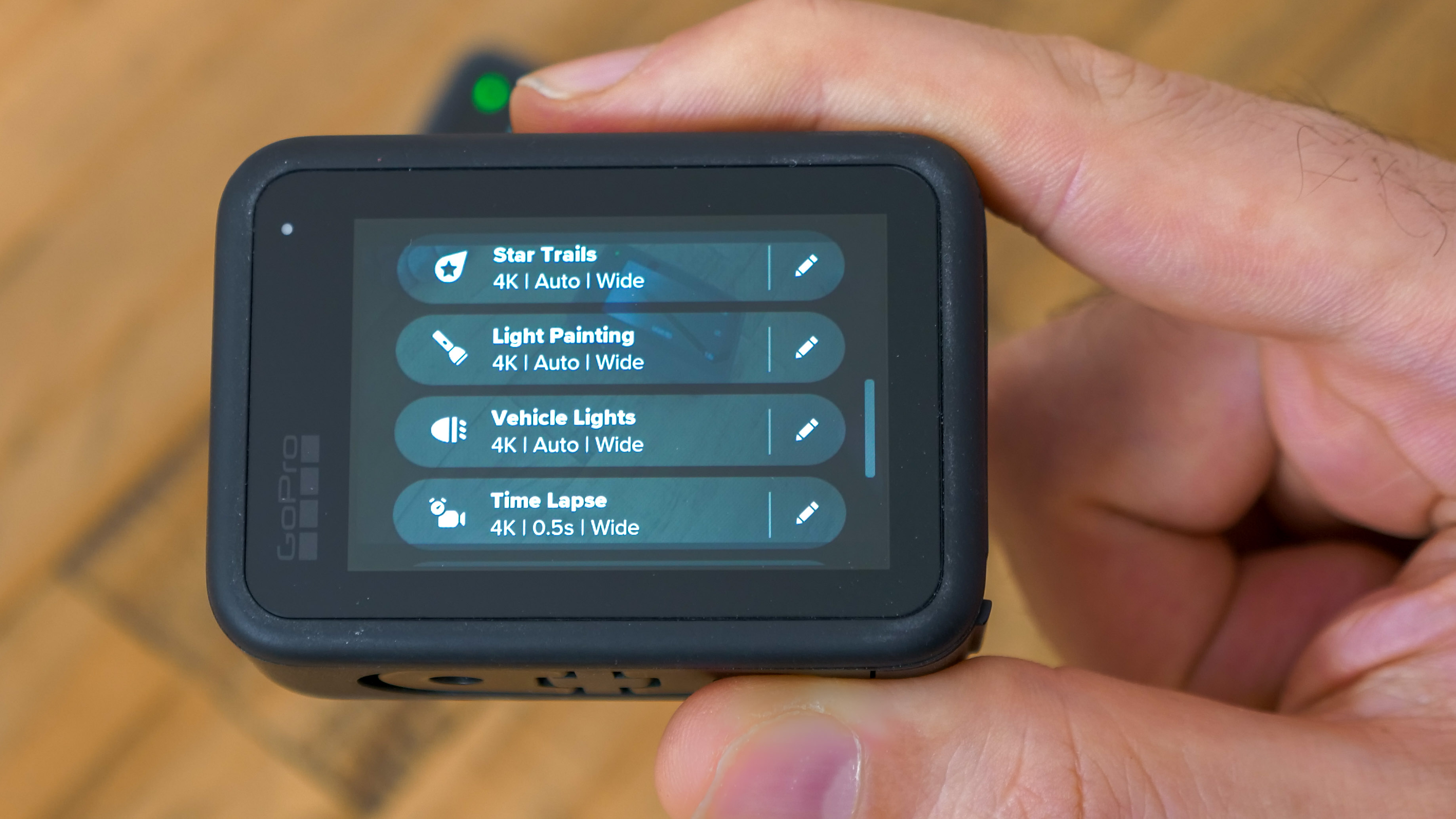
The third new preset is Star Trails, which makes use of the earth’s rotation to create star trails across the night sky. Naturally, you’ll only be able to use this feature in certain conditions, but it’s a nice option to have if you’re camping out in the wilderness.
Meanwhile, Night Photo combines a longer exposure and a degree of computational photography to help eke out a usable snap from the Hero 11 Black's camera even in dimly-lit scenes. This works well on a tripod, and bests the Osmo Action 3's efforts when handheld. That said, the results will unlikely outperform a modern-day smartphone, so if you have anything newer than an iPhone 12 or a Google Pixel 5, you'd be better off switching to your mobile when the lights drop.
GoPro Hero 11 Black vs DJI Osmo Action 3: Software
One of the great new features introduced on the GoPro Hero 11 Black is its simpler, more stripped-back software that makes shooting a breeze for novices and seasoned pros alike. Users can select either Easy, or Pro controls when they set up their 11 Black, or switch between the two with a few swipes.
While Pro controls give you all the options available on previous GoPro cameras – frame rate, resolution, aspect ratio, and more – Easy translates everything into plain and simple language. There are fewer settings in Easy mode so that users can focus more on footage and less on settings.
DJI's camera interface is user-friendly, but doesn't offer an Easy mode, so might still boggle folks new to the world of action cameras.
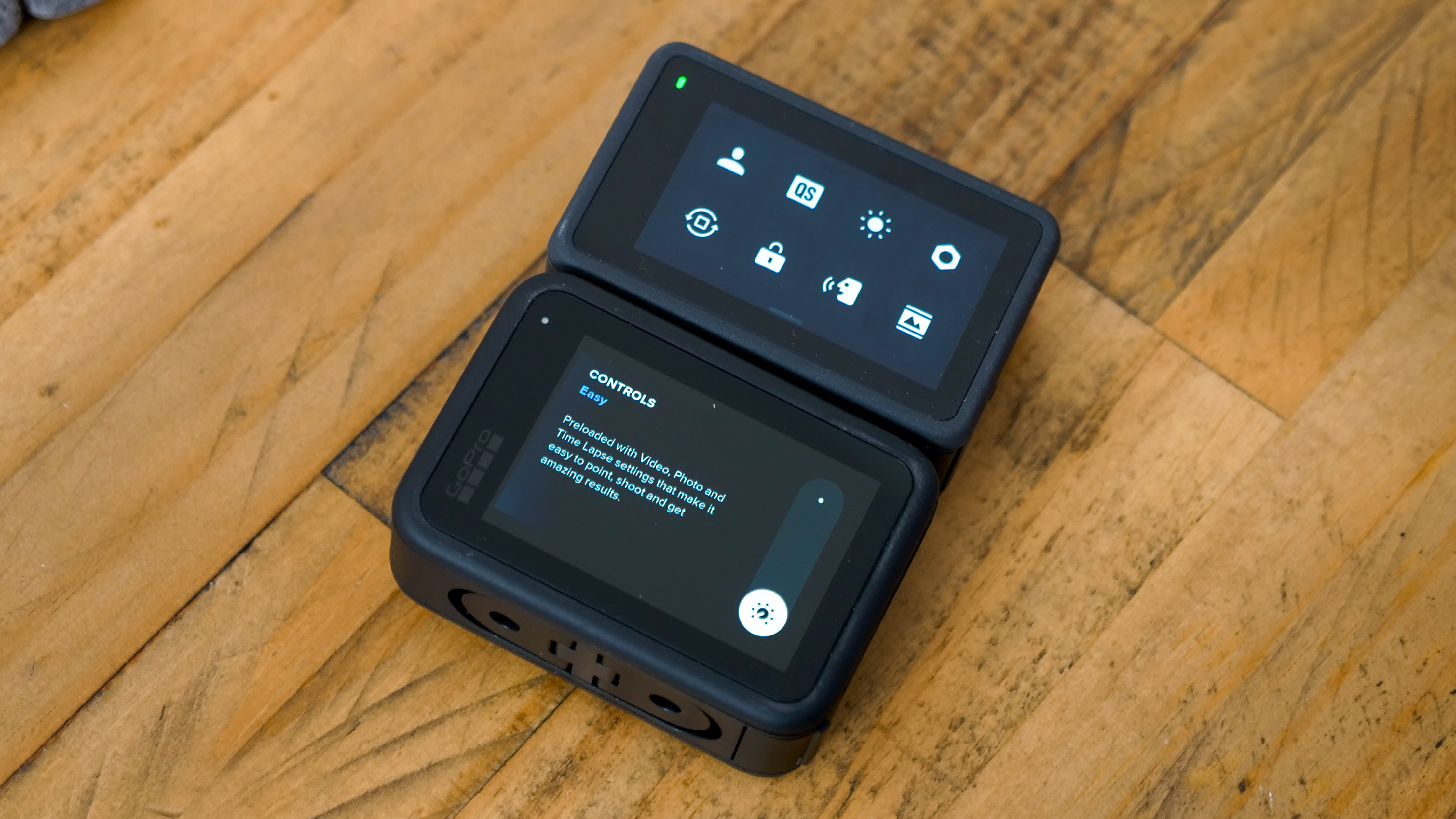
Software differences between the Hero 11 Black and DJI Osmo Action 3 aren't limited to in-camera options. The smartphone apps available for both phones also give users different tools to play with.
While both action camera apps offer comprehensive control over the shooting experience, we found the DJI Mimo app to hold a stronger connection with its respective action camera than the GoPro Quik app. That said, GoPro offers more editing options than DJI, including the freedom to create montages of your clips, and a new Auto Highlight option for GoPro subscribers.
Auto Highlight automatically generates a montage using the footage on your camera that's been automatically uploaded to the cloud, possibly saving you needing to edit your footage ever again.
GoPro Hero 11 Black vs DJI Osmo Action 3: which should you buy?
If your main concern is bang-for-buck and battery superiority, then the DJI Osmo Action 3 is our choice. With its lower price, deep sea diving chassis, and fantastic accessory suite when you pick it up with the Adventurer's Combo, DJI has undercut GoPro by some margin, and created a compelling package.
For anyone who wants the very best footage on offer in an action camera, not to mention maximum versatility when it comes to resolutions, aspect ratios, and playful modes, the GoPro Hero 11 Black is the obvious choice.
You'll be paying more for GoPro's flagship action camera than DJI's, but its video capture quality alone will likely justify the price difference for many. GoPro's image processing captures superior dynamic range, more pleasing colors, and more stable footage, specifically when shooting a 360-degree horizon lock at maximum resolution.
The Hero 11 Black's new 8:7 sensor is also very compelling for social media users, capable of capturing clips that can easily be cropped in the powerful GoPro Quick app, then uploaded in 9:16 on TikTok, 1:1 on Instagram, and 16:9 on YouTube.
Add to the mix GoPro's novel night modes, which bring Light Painting to the line, its simple UI, and the host of Mods available on the Hero line, and while DJI puts up a mighty fight, especially on the value and battery life fronts, GoPro has ultimately created the best action camera of 2022 in the Hero 11 Black.

Basil Kronfli is the Head of content at Make Honey and freelance technology journalist. He is an experienced writer and producer and is skilled in video production, and runs the technology YouTube channel TechEdit.